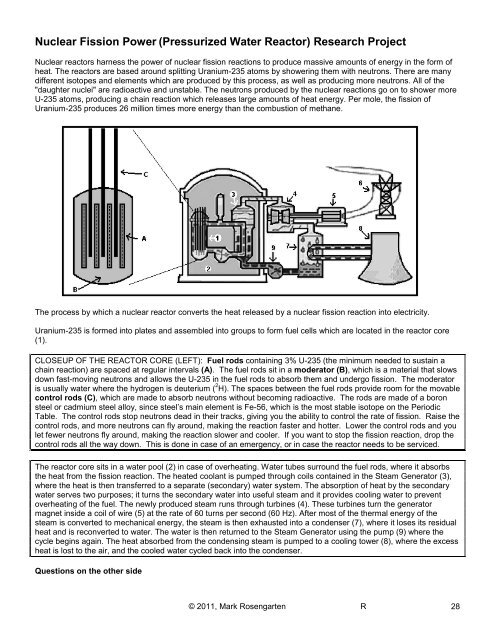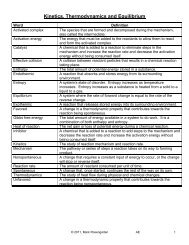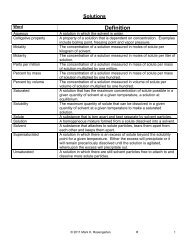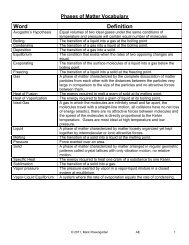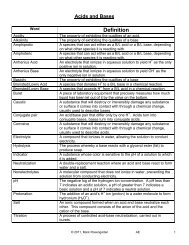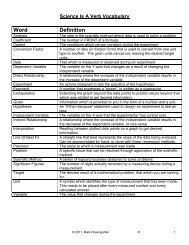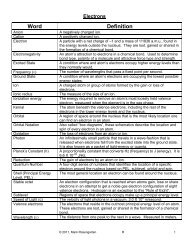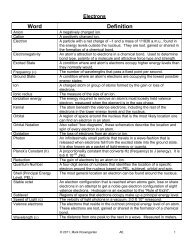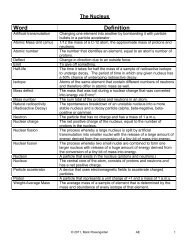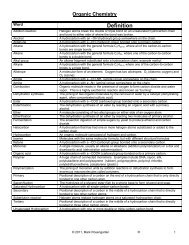Unit 4 - Mark Rosengarten
Unit 4 - Mark Rosengarten
Unit 4 - Mark Rosengarten
Create successful ePaper yourself
Turn your PDF publications into a flip-book with our unique Google optimized e-Paper software.
Nuclear Fission Power (Pressurized Water Reactor) Research Project<br />
Nuclear reactors harness the power of nuclear fission reactions to produce massive amounts of energy in the form of<br />
heat. The reactors are based around splitting Uranium-235 atoms by showering them with neutrons. There are many<br />
different isotopes and elements which are produced by this process, as well as producing more neutrons. All of the<br />
"daughter nuclei" are radioactive and unstable. The neutrons produced by the nuclear reactions go on to shower more<br />
U-235 atoms, producing a chain reaction which releases large amounts of heat energy. Per mole, the fission of<br />
Uranium-235 produces 26 million times more energy than the combustion of methane.<br />
The process by which a nuclear reactor converts the heat released by a nuclear fission reaction into electricity.<br />
Uranium-235 is formed into plates and assembled into groups to form fuel cells which are located in the reactor core<br />
(1).<br />
CLOSEUP OF THE REACTOR CORE (LEFT): Fuel rods containing 3% U-235 (the minimum needed to sustain a<br />
chain reaction) are spaced at regular intervals (A). The fuel rods sit in a moderator (B), which is a material that slows<br />
down fast-moving neutrons and allows the U-235 in the fuel rods to absorb them and undergo fission. The moderator<br />
is usually water where the hydrogen is deuterium ( 2 H). The spaces between the fuel rods provide room for the movable<br />
control rods (C), which are made to absorb neutrons without becoming radioactive. The rods are made of a boron<br />
steel or cadmium steel alloy, since steel’s main element is Fe-56, which is the most stable isotope on the Periodic<br />
Table. The control rods stop neutrons dead in their tracks, giving you the ability to control the rate of fission. Raise the<br />
control rods, and more neutrons can fly around, making the reaction faster and hotter. Lower the control rods and you<br />
let fewer neutrons fly around, making the reaction slower and cooler. If you want to stop the fission reaction, drop the<br />
control rods all the way down. This is done in case of an emergency, or in case the reactor needs to be serviced.<br />
The reactor core sits in a water pool (2) in case of overheating. Water tubes surround the fuel rods, where it absorbs<br />
the heat from the fission reaction. The heated coolant is pumped through coils contained in the Steam Generator (3),<br />
where the heat is then transferred to a separate (secondary) water system. The absorption of heat by the secondary<br />
water serves two purposes; it turns the secondary water into useful steam and it provides cooling water to prevent<br />
overheating of the fuel. The newly produced steam runs through turbines (4). These turbines turn the generator<br />
magnet inside a coil of wire (5) at the rate of 60 turns per second (60 Hz). After most of the thermal energy of the<br />
steam is converted to mechanical energy, the steam is then exhausted into a condenser (7), where it loses its residual<br />
heat and is reconverted to water. The water is then returned to the Steam Generator using the pump (9) where the<br />
cycle begins again. The heat absorbed from the condensing steam is pumped to a cooling tower (8), where the excess<br />
heat is lost to the air, and the cooled water cycled back into the condenser.<br />
Questions on the other side<br />
© 2011, <strong>Mark</strong> <strong>Rosengarten</strong> R 28


